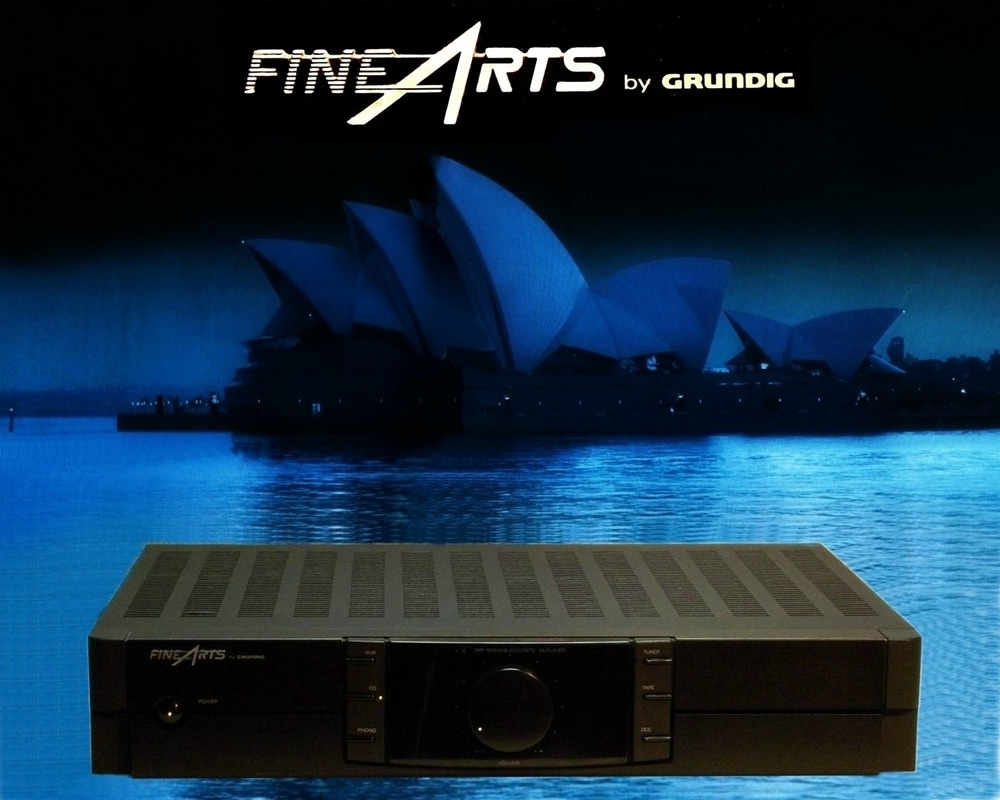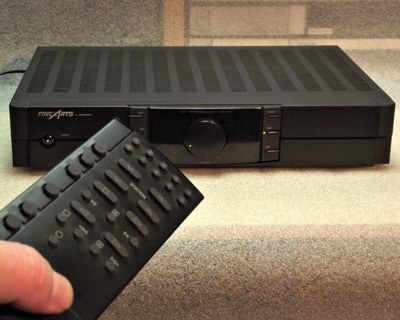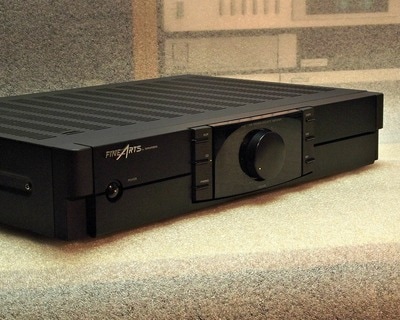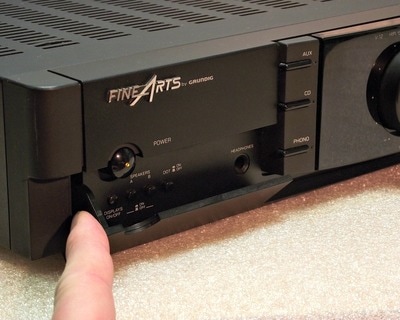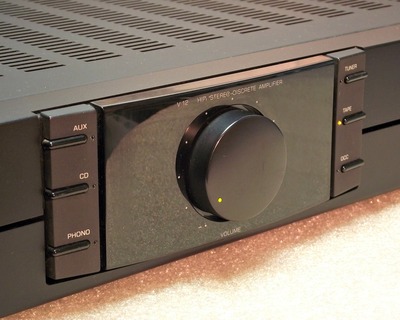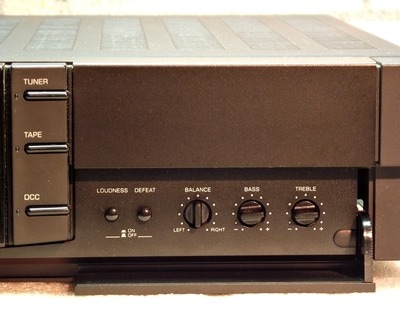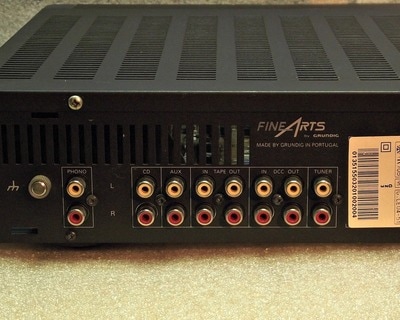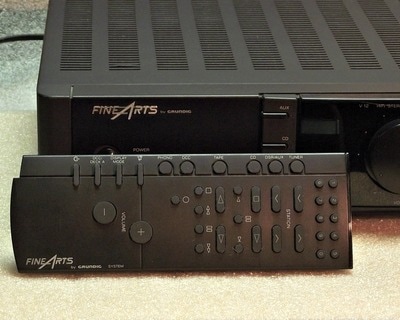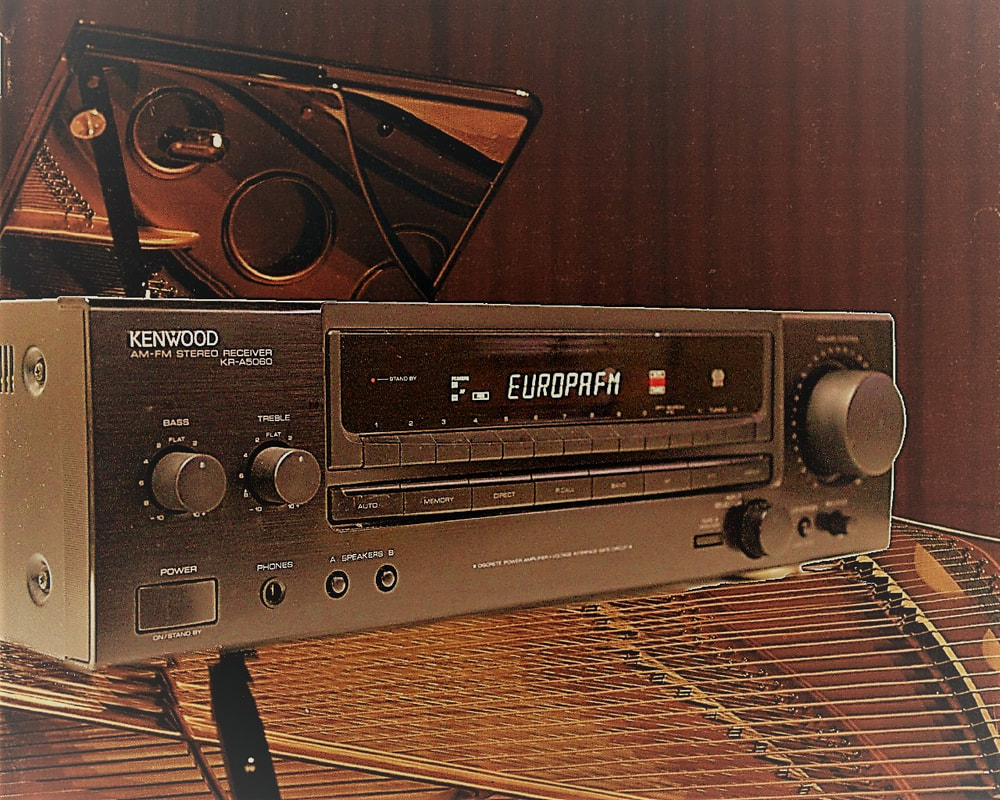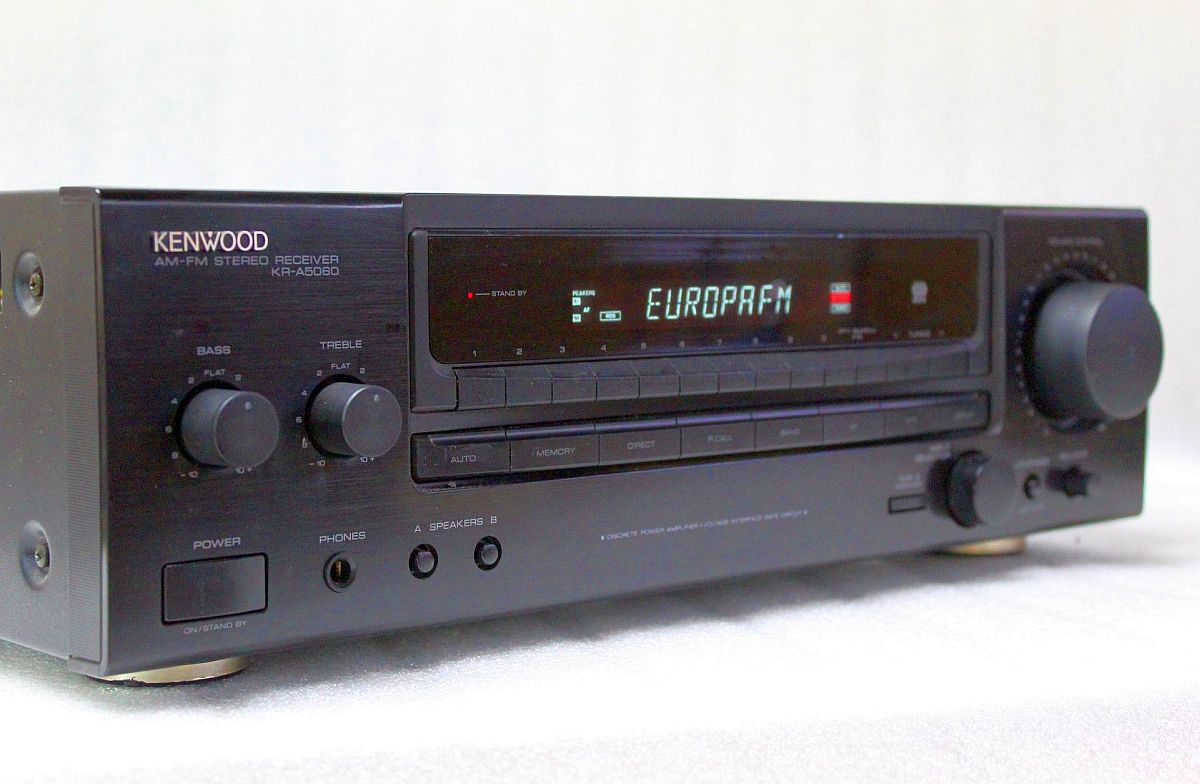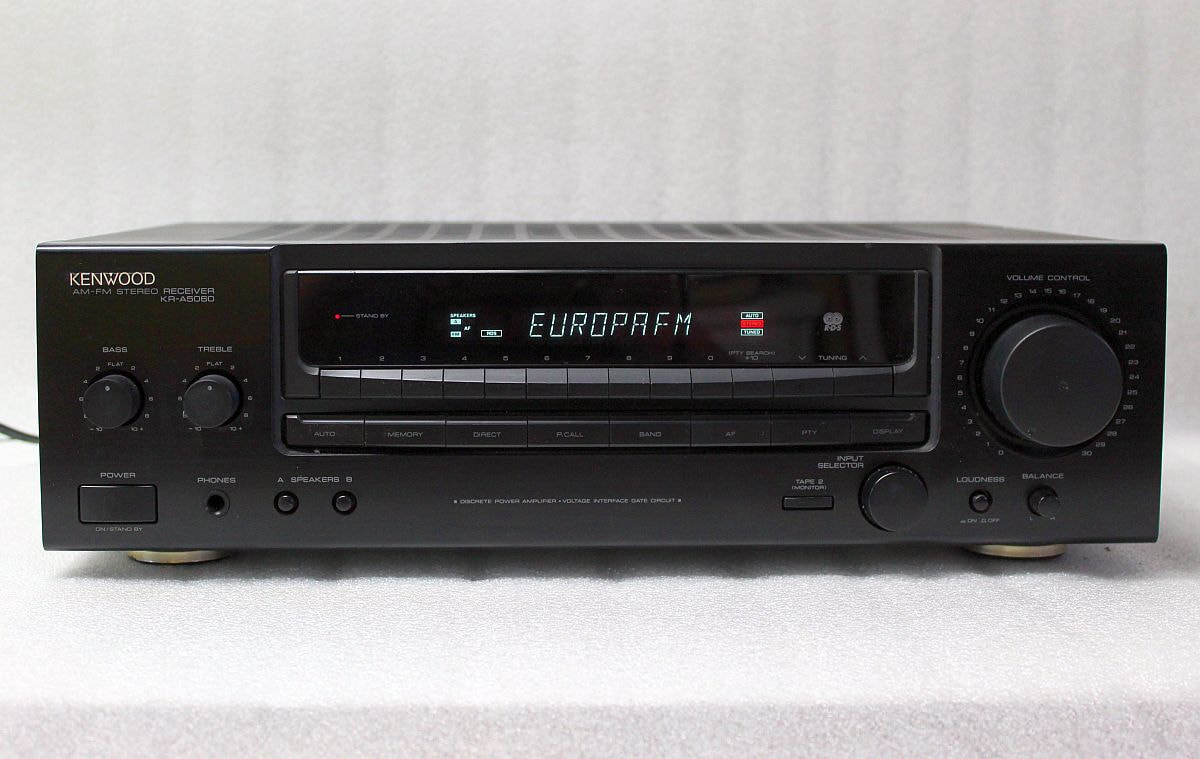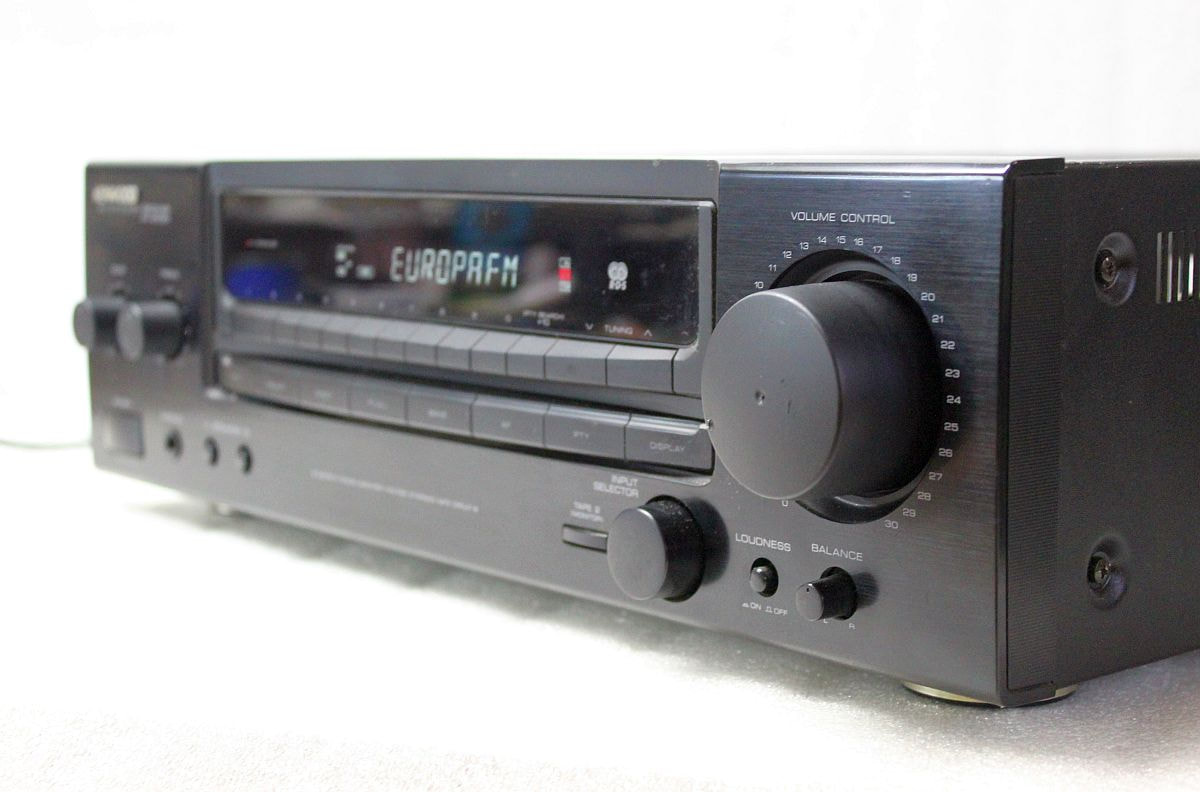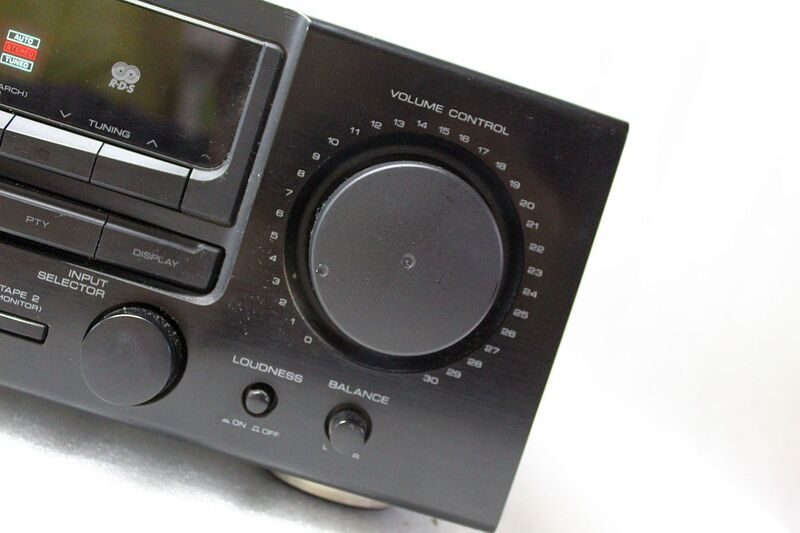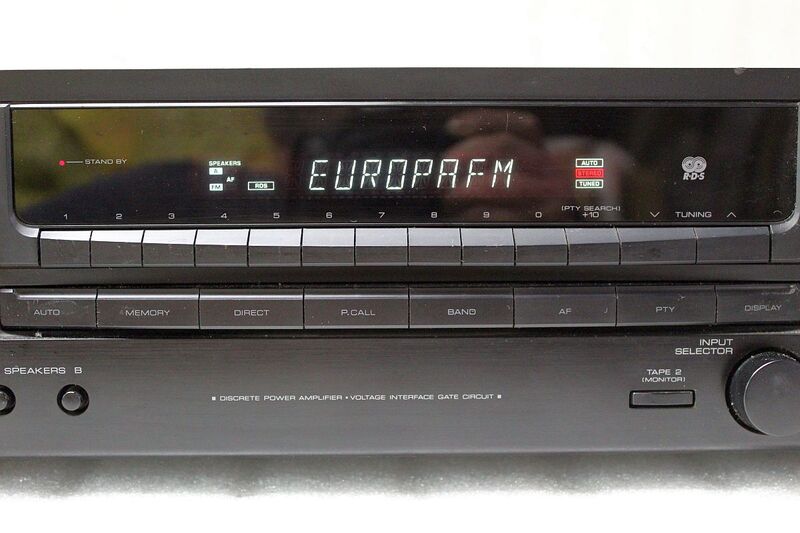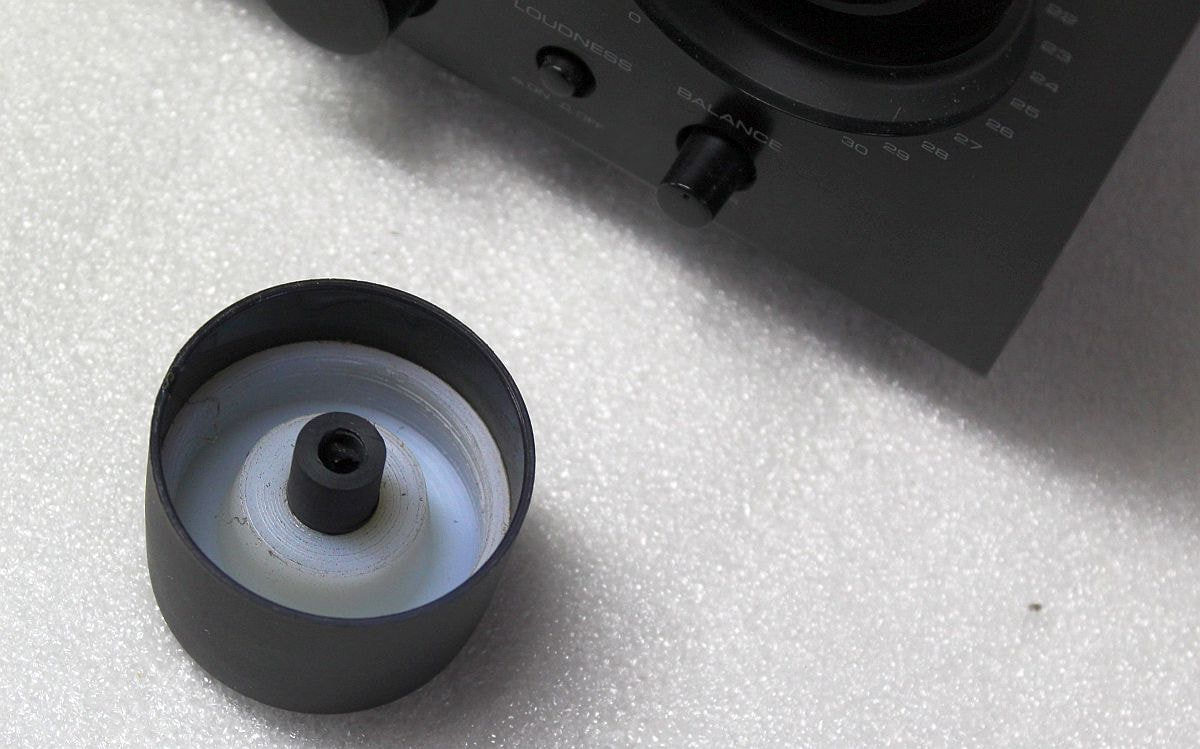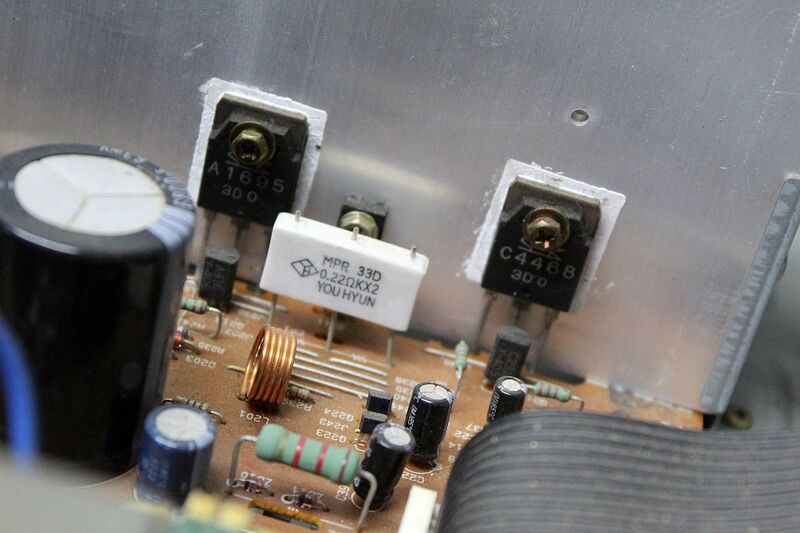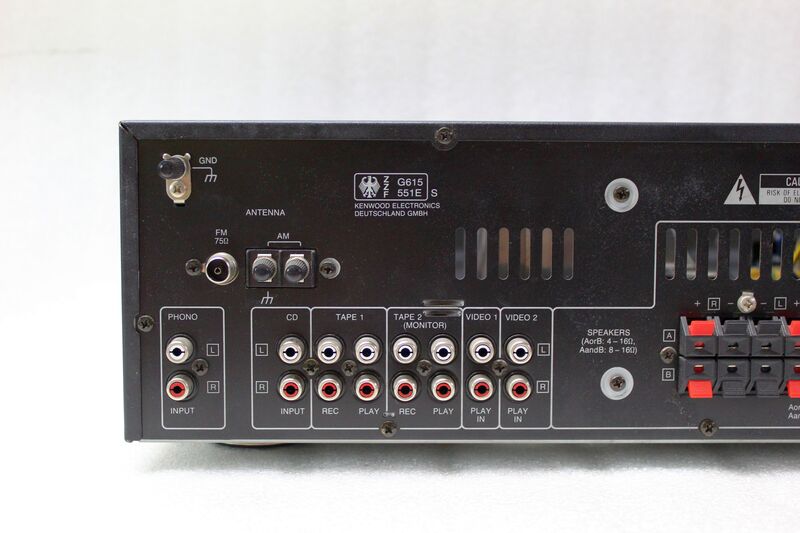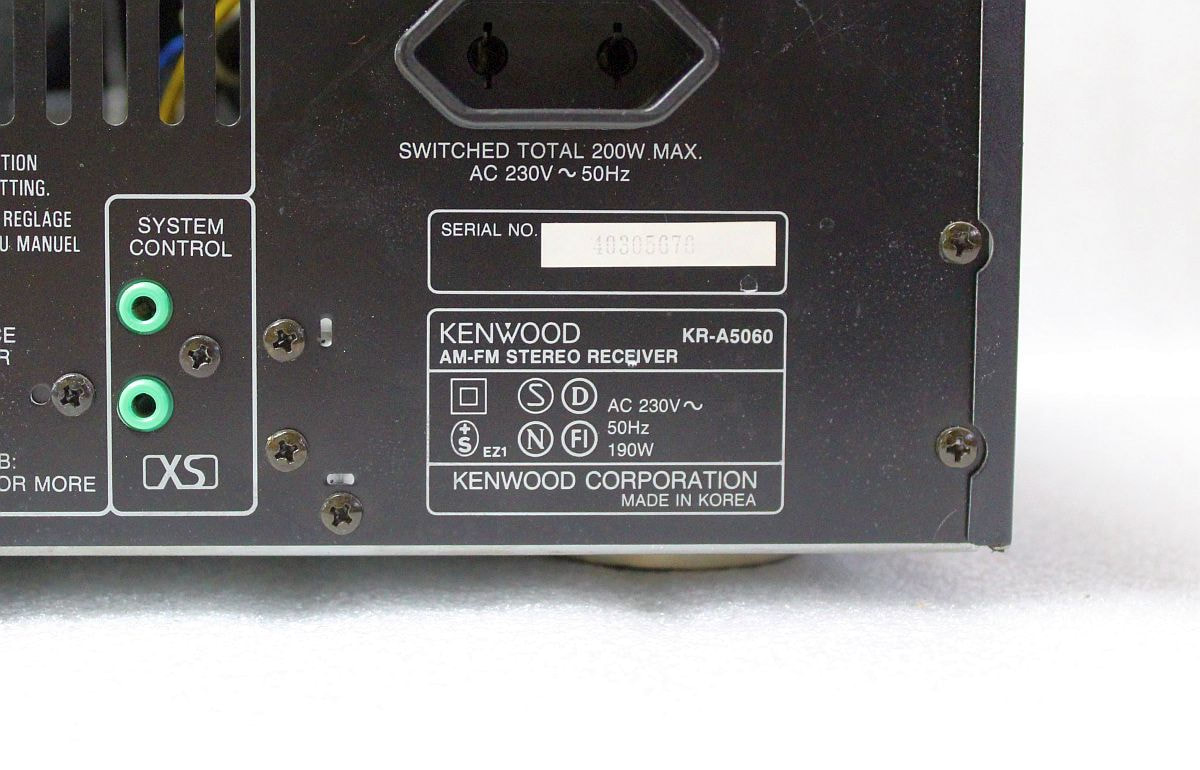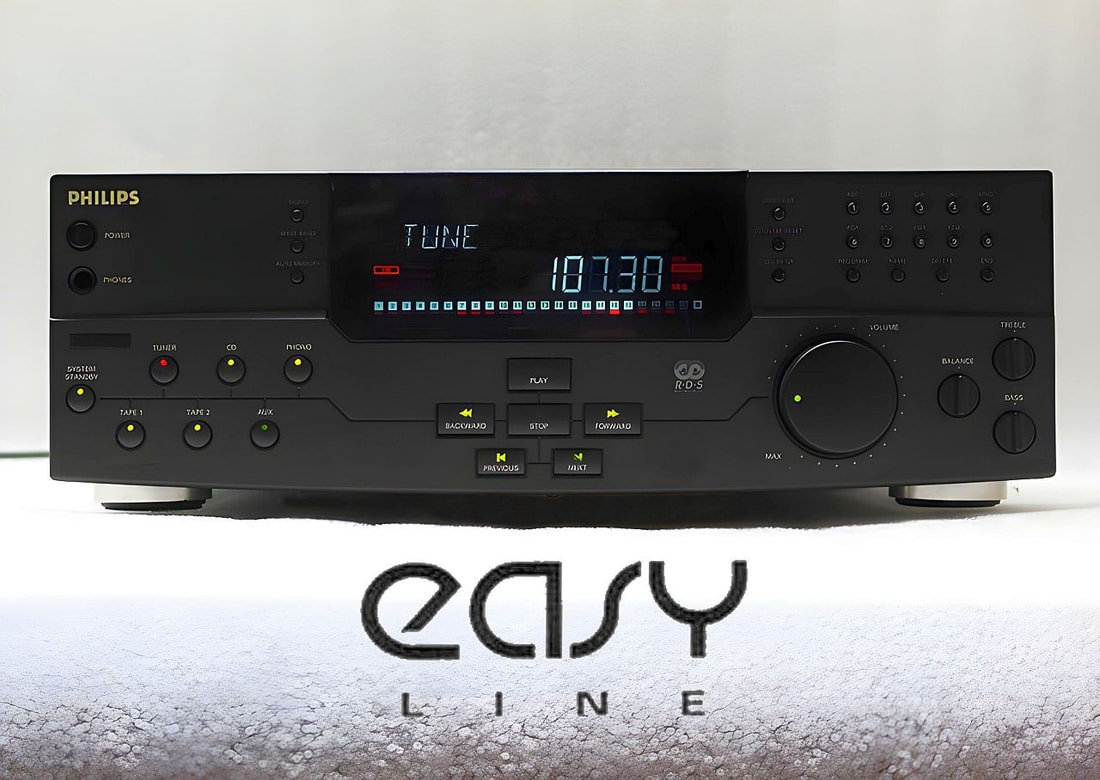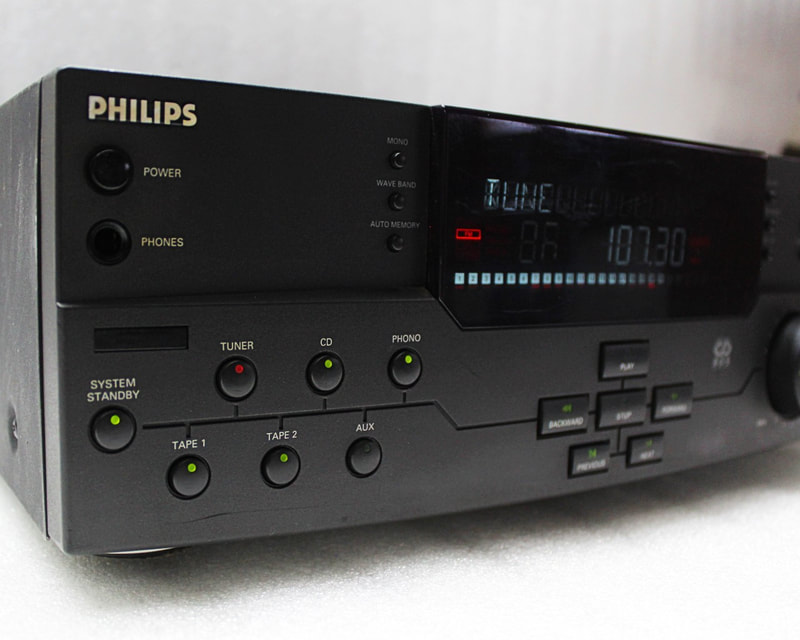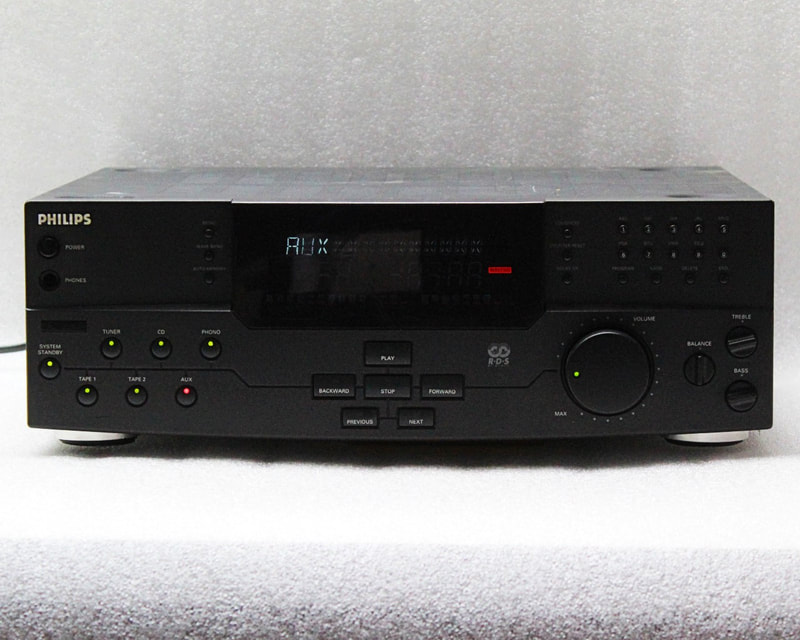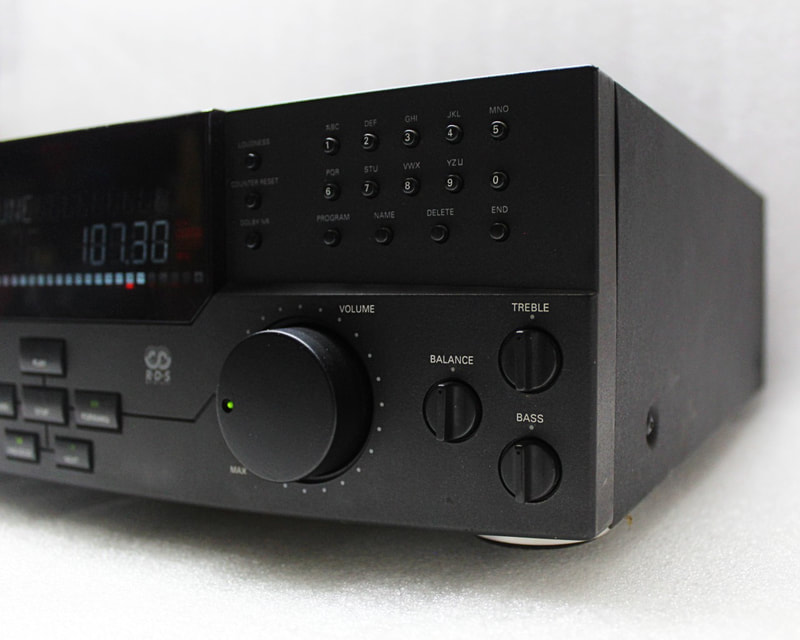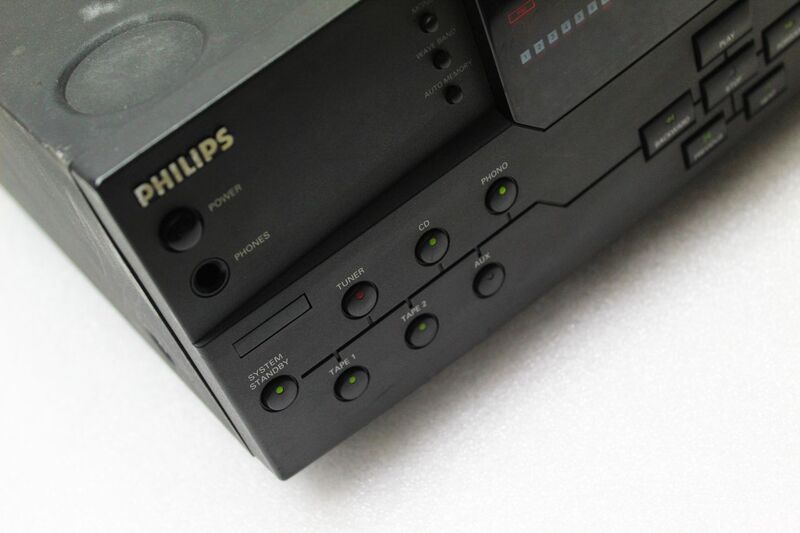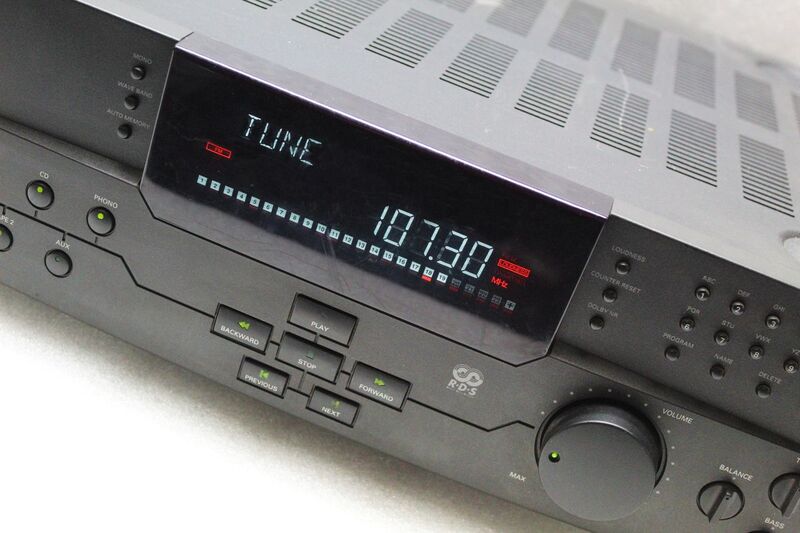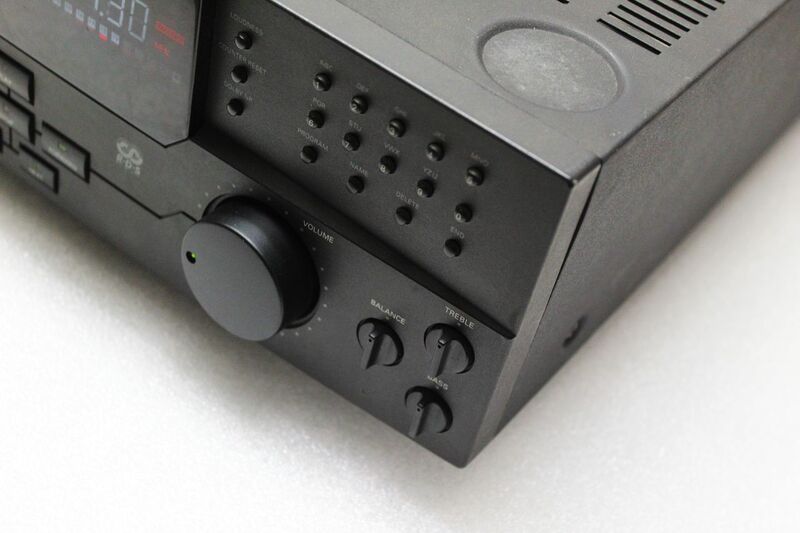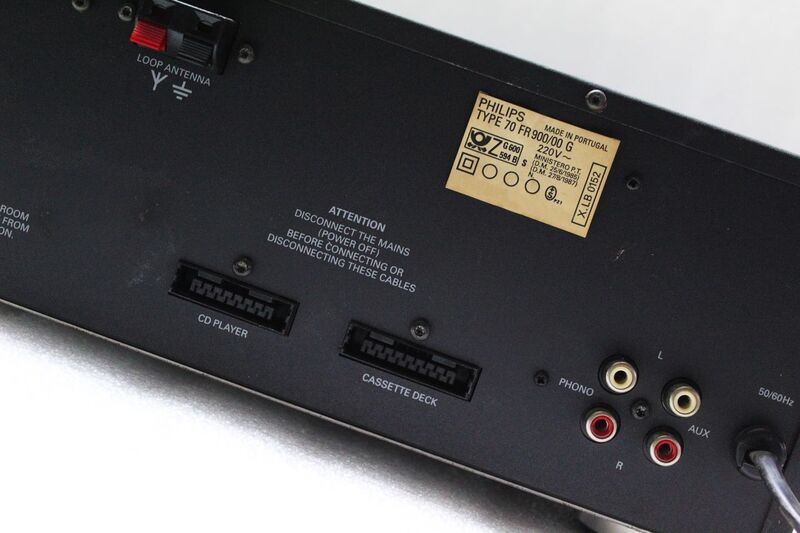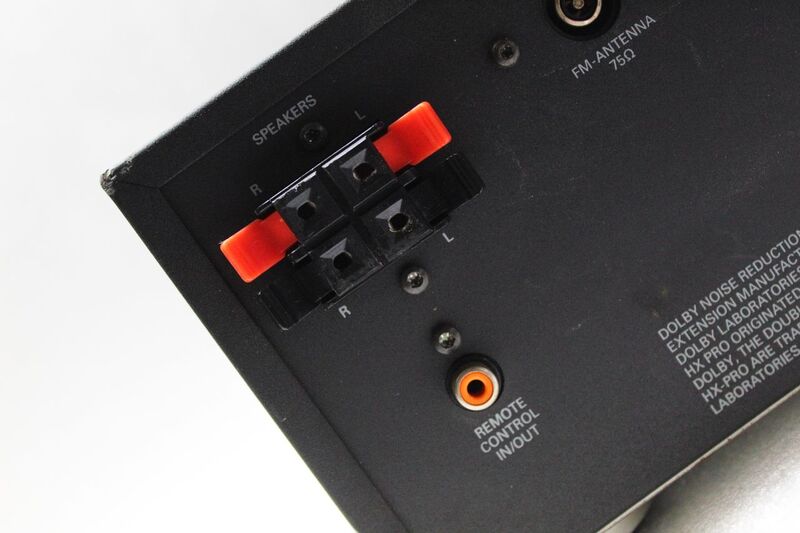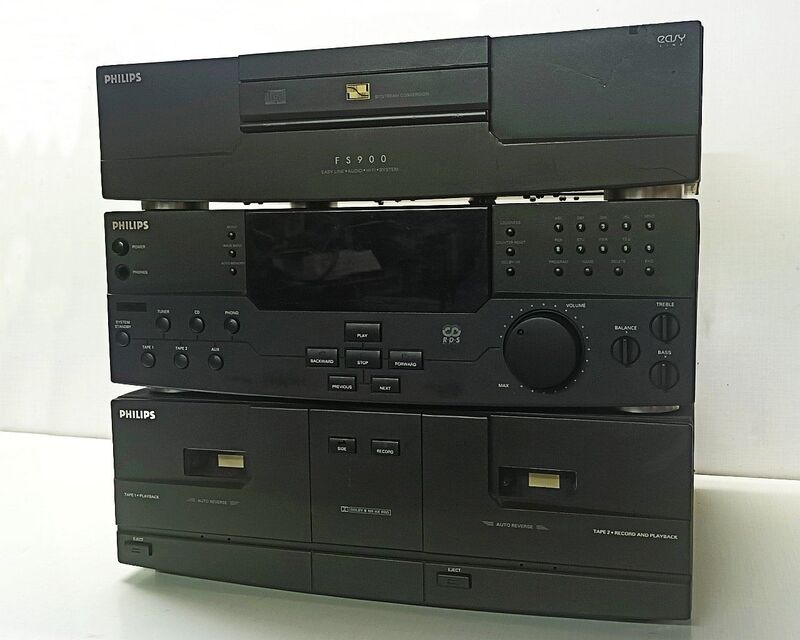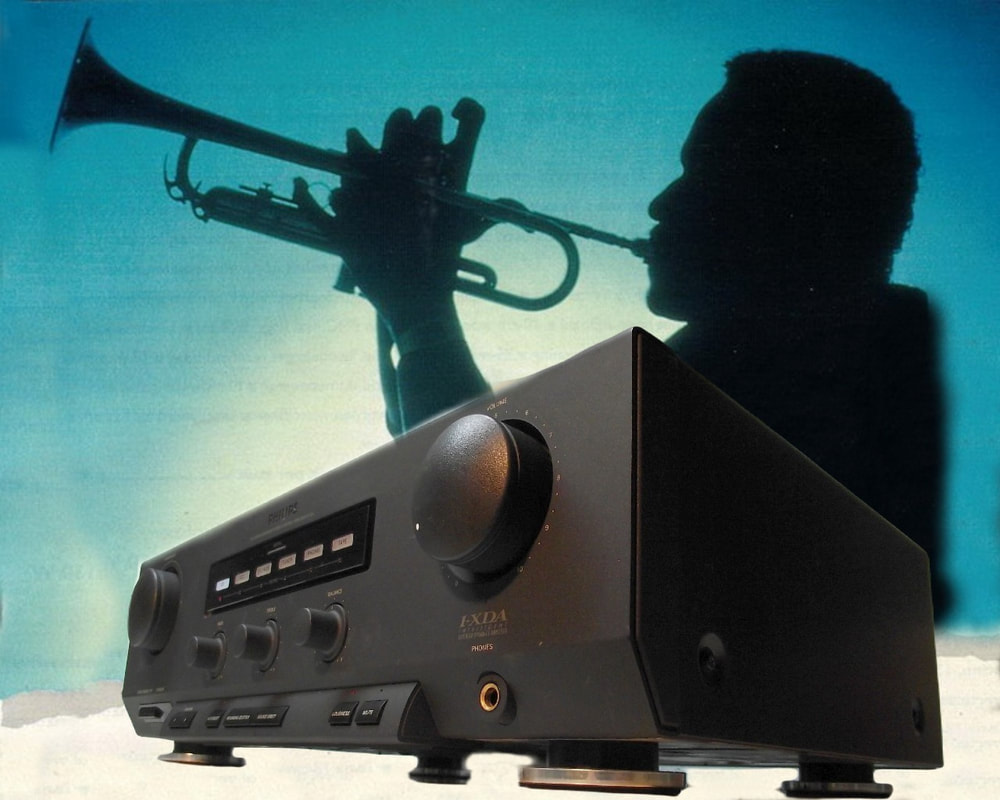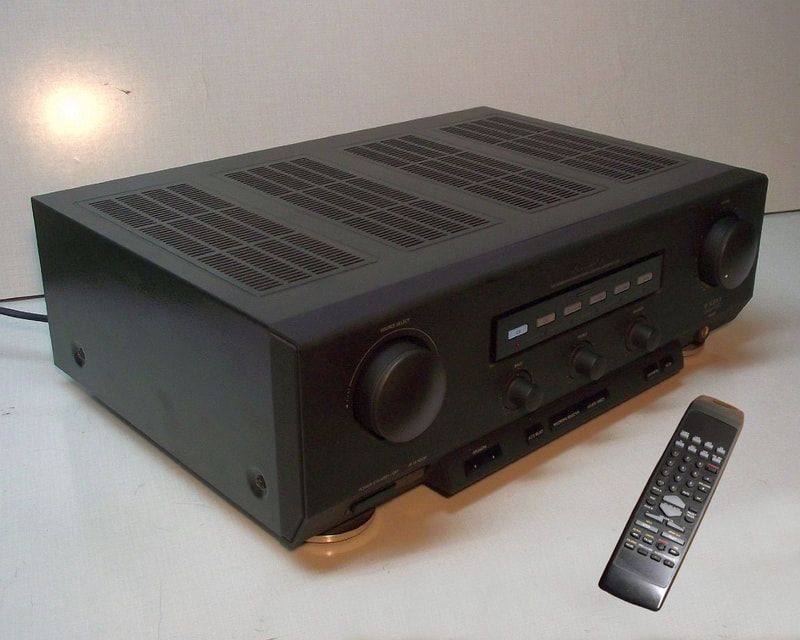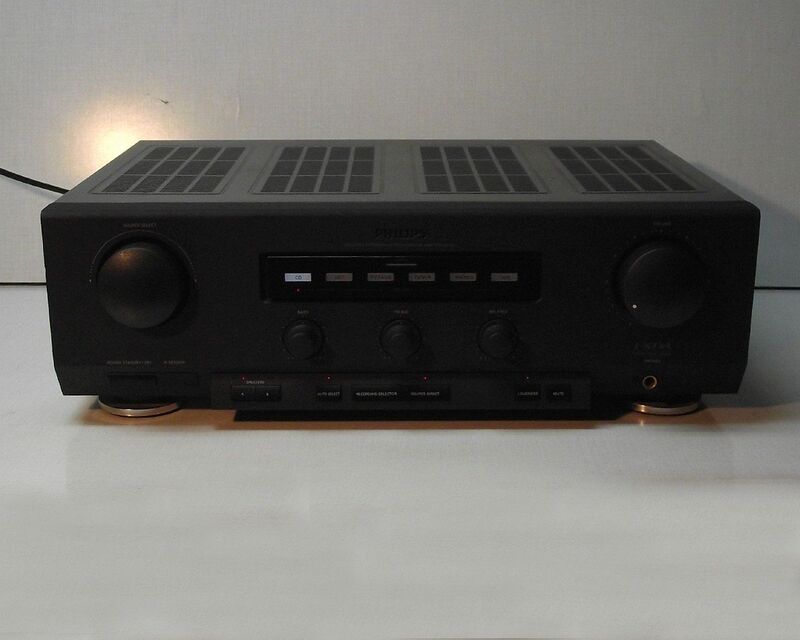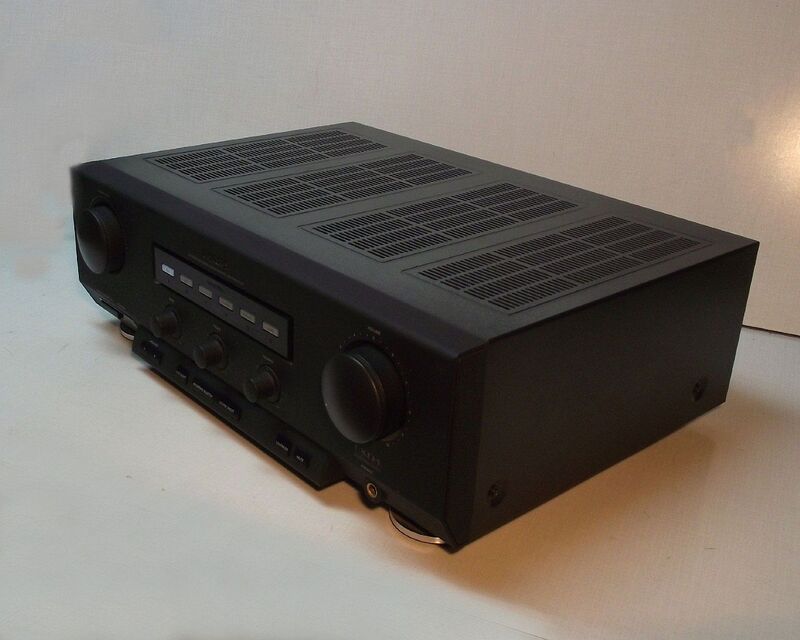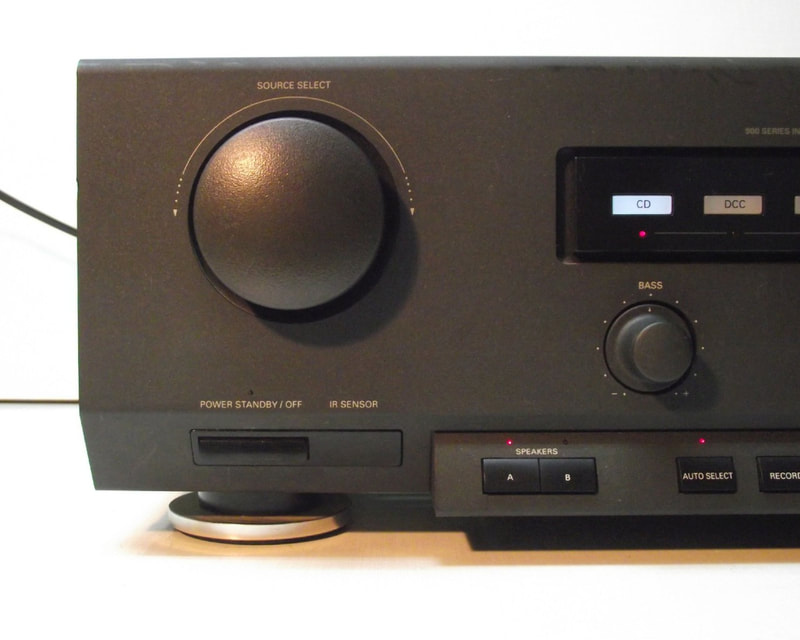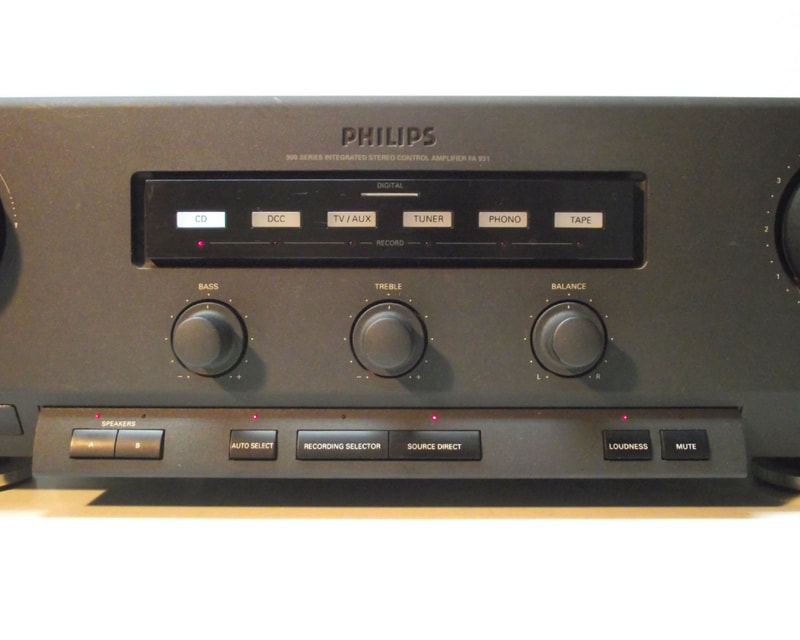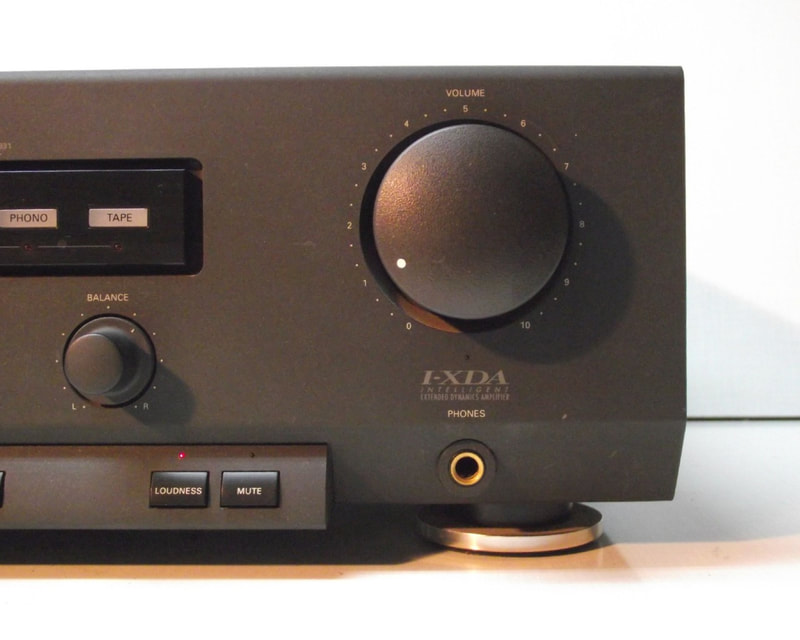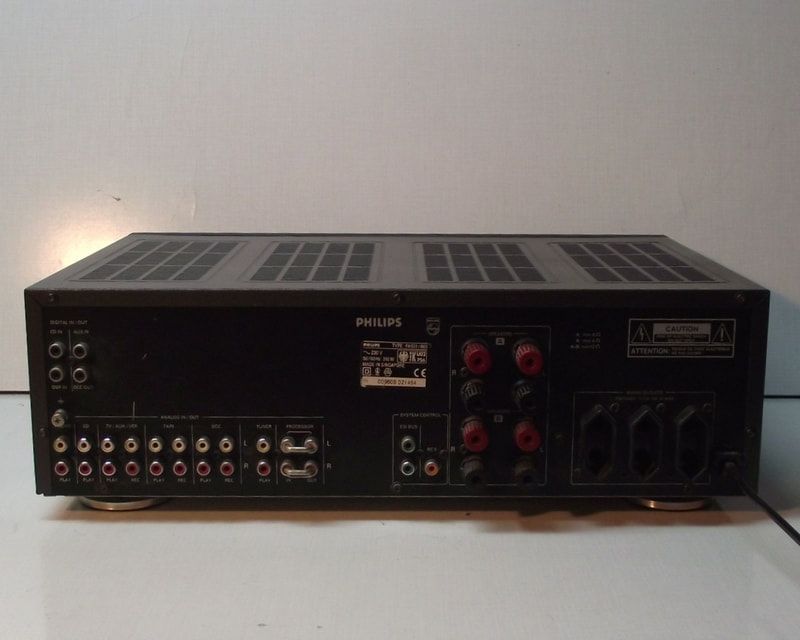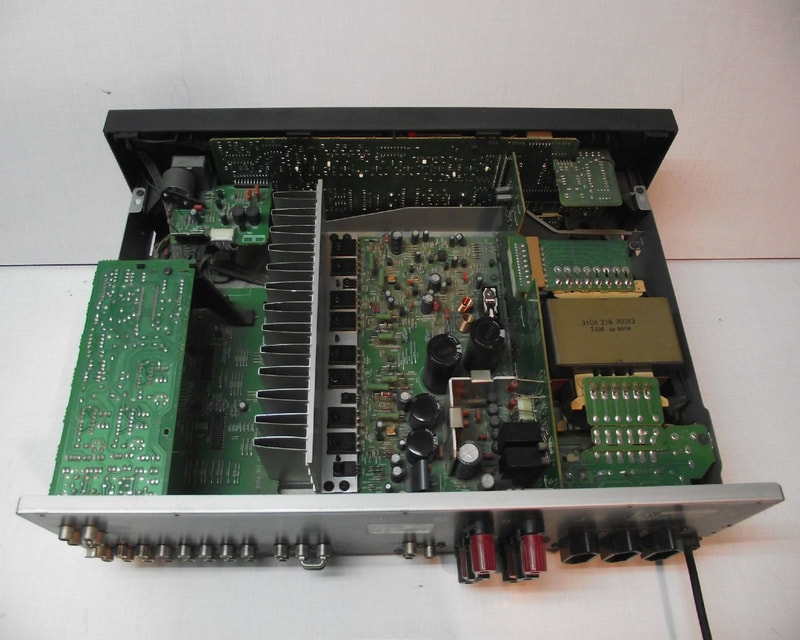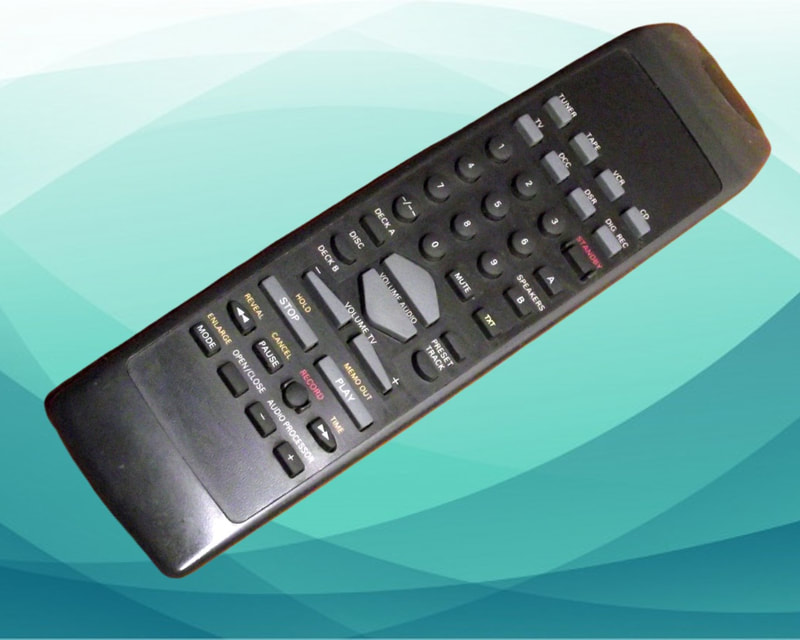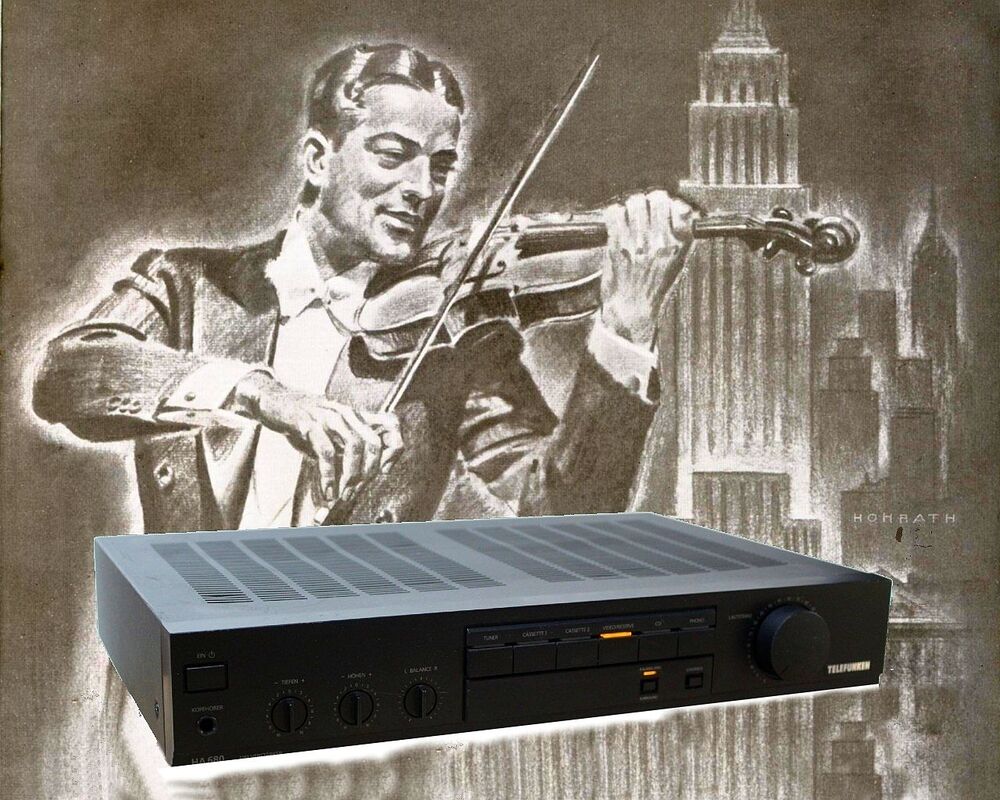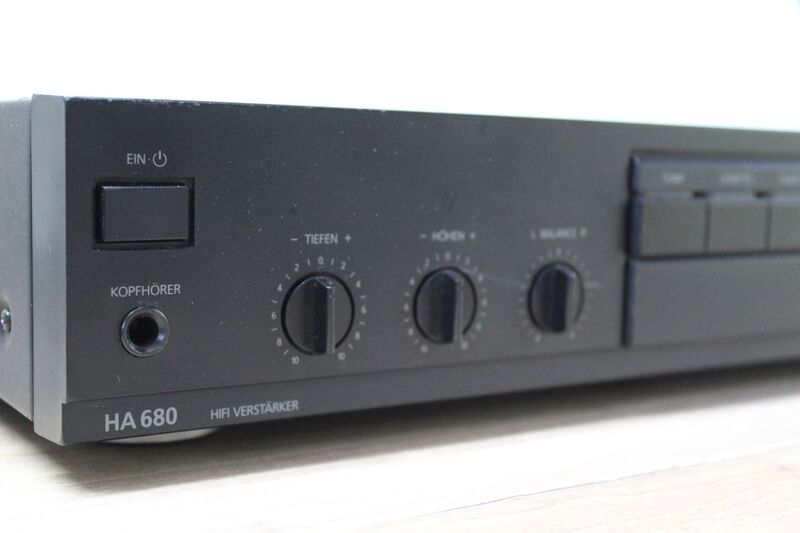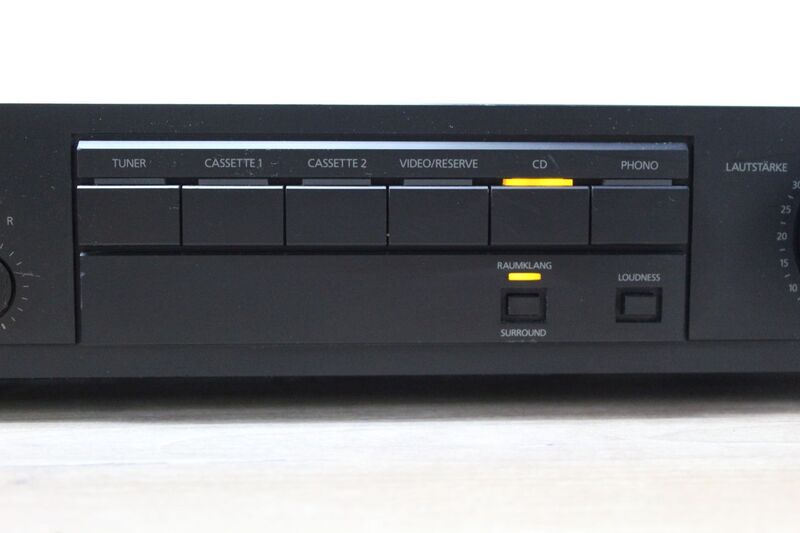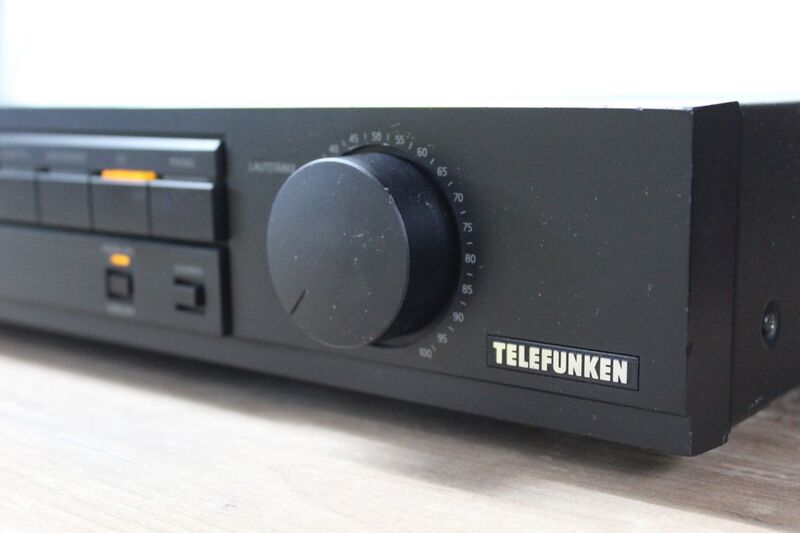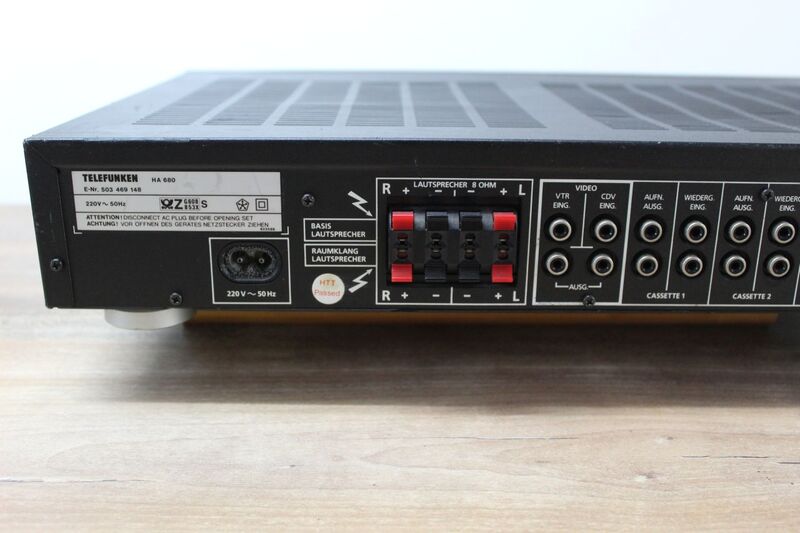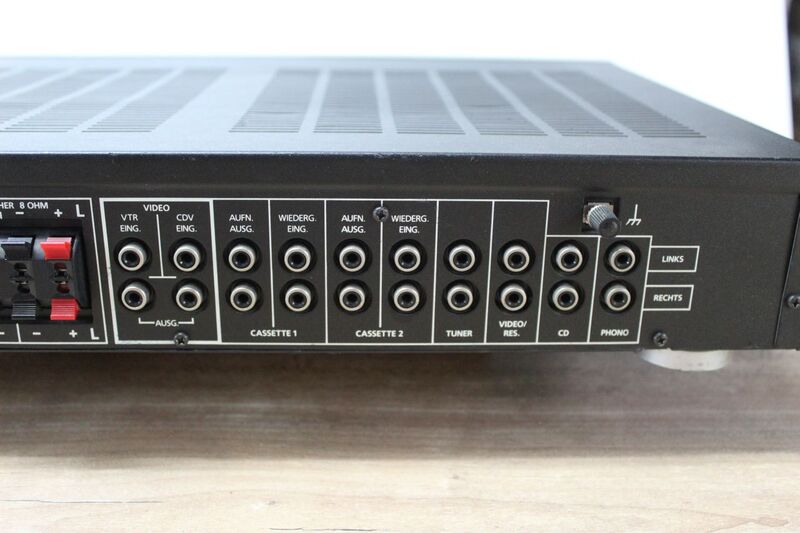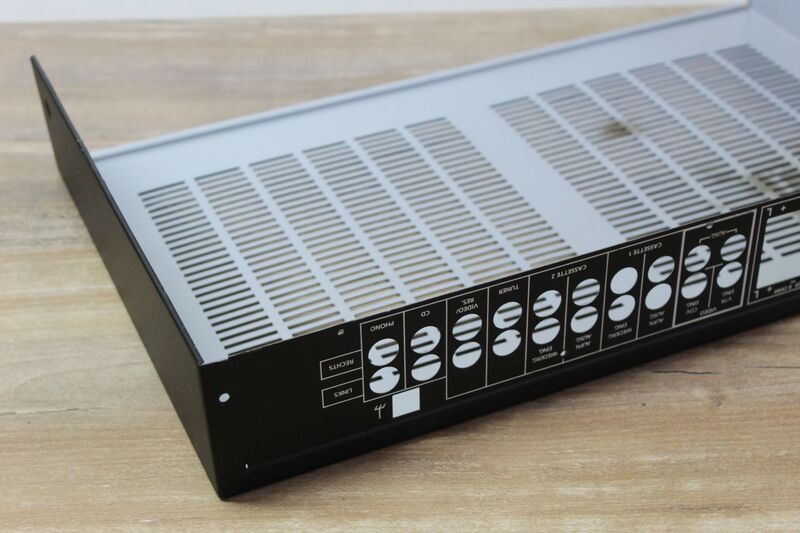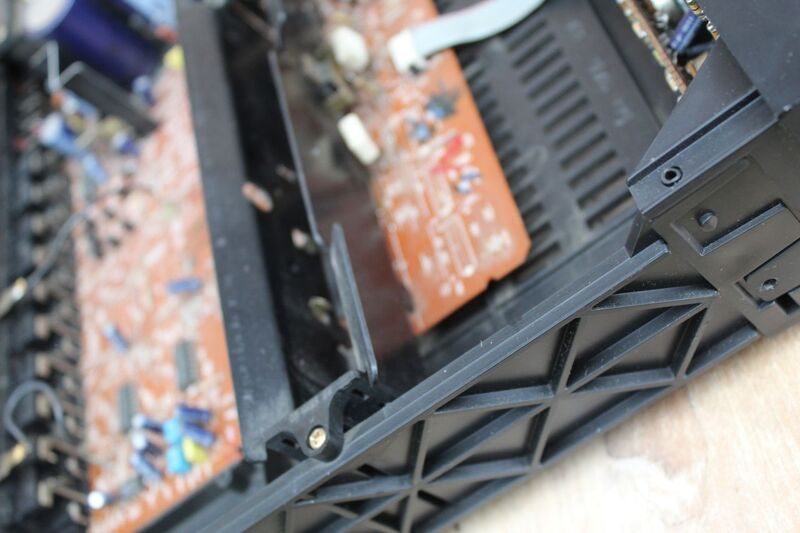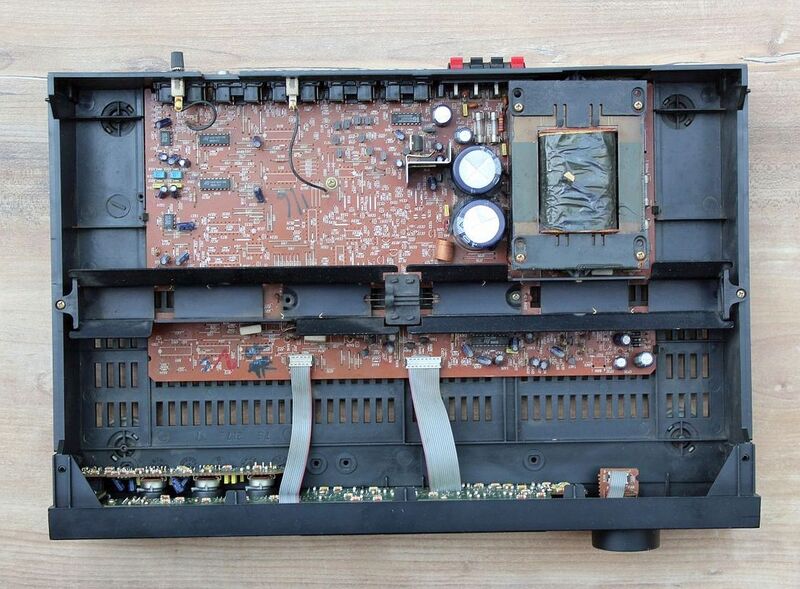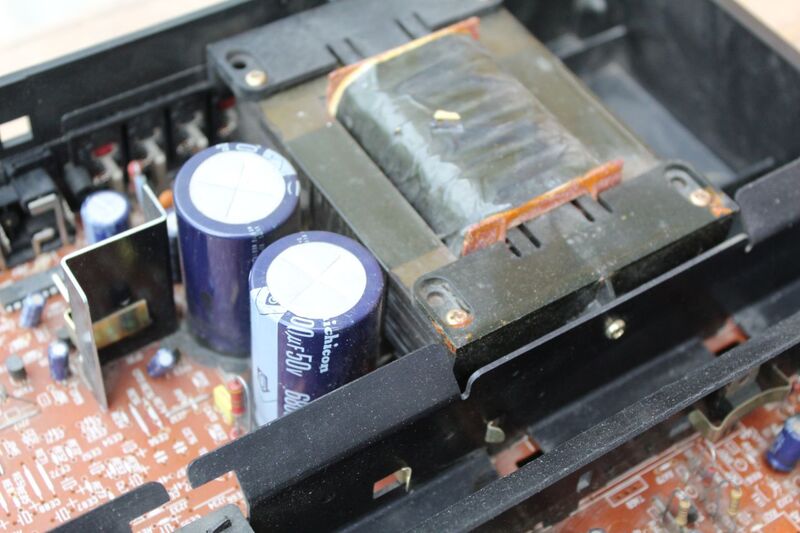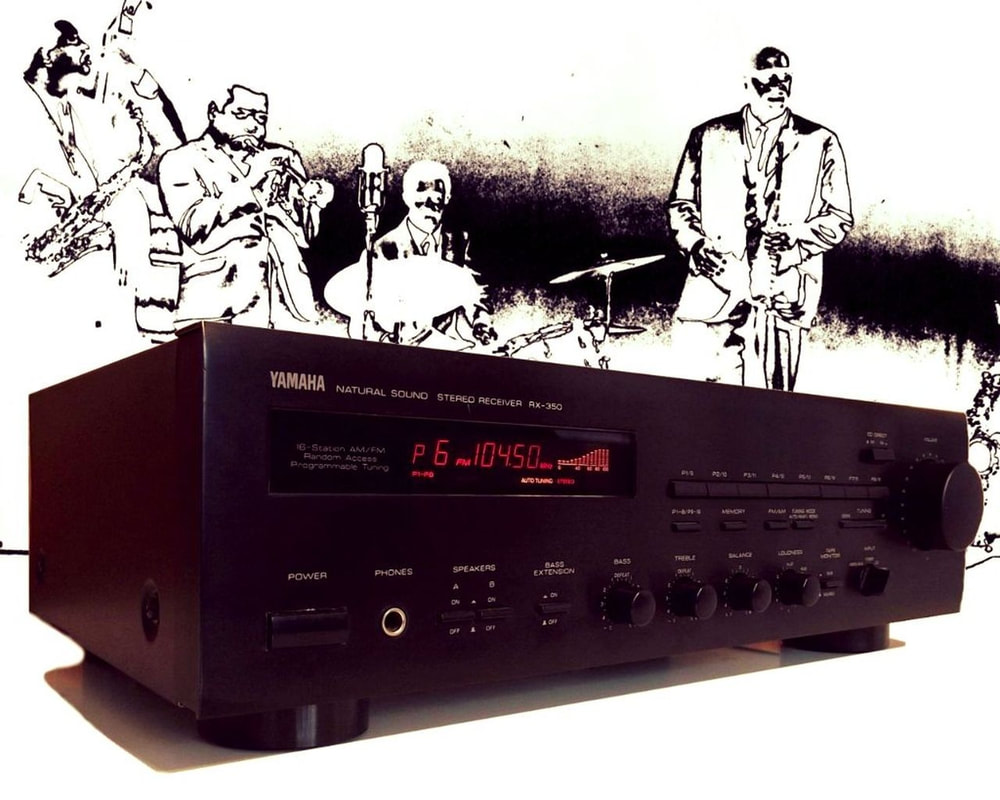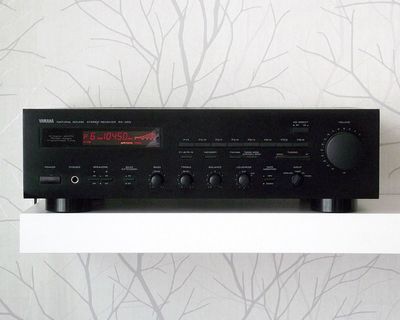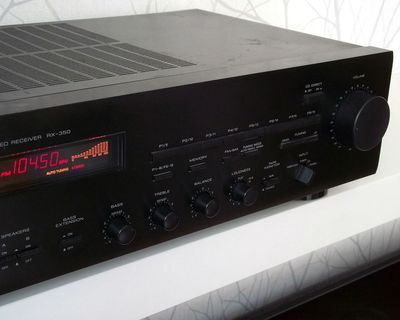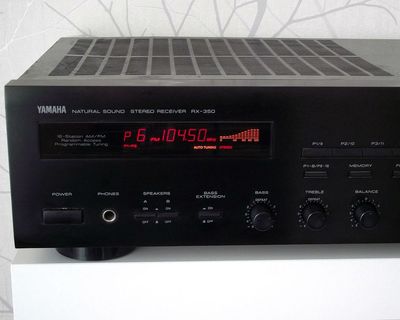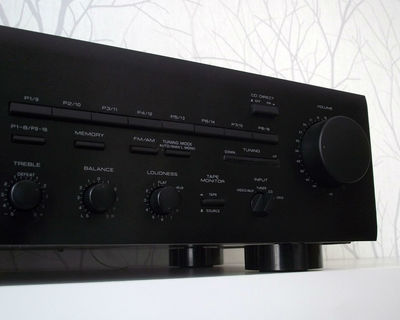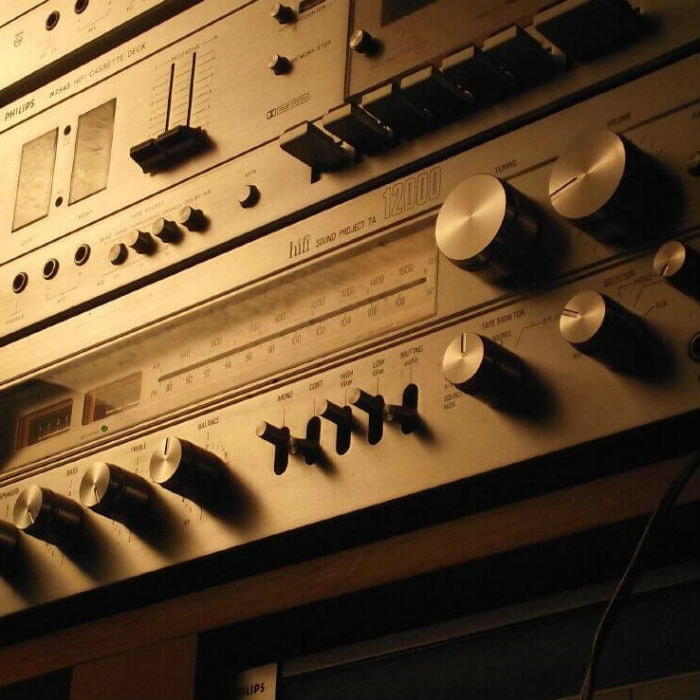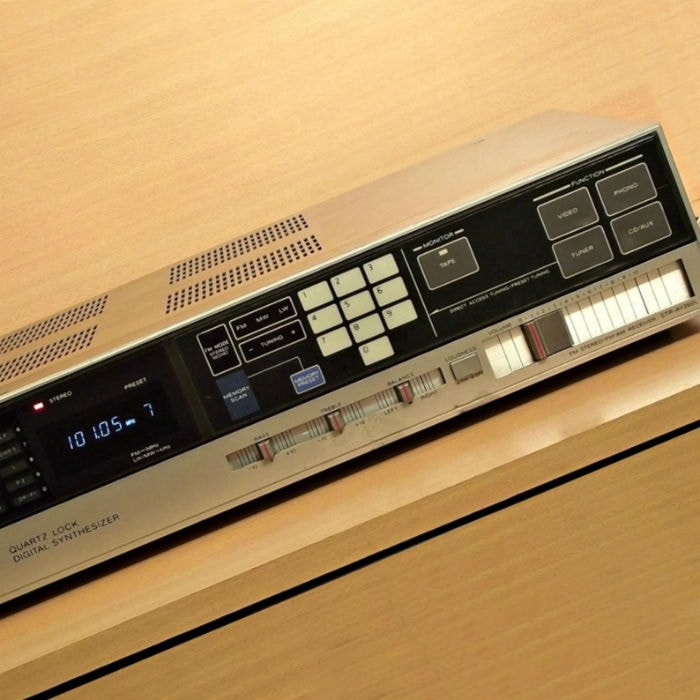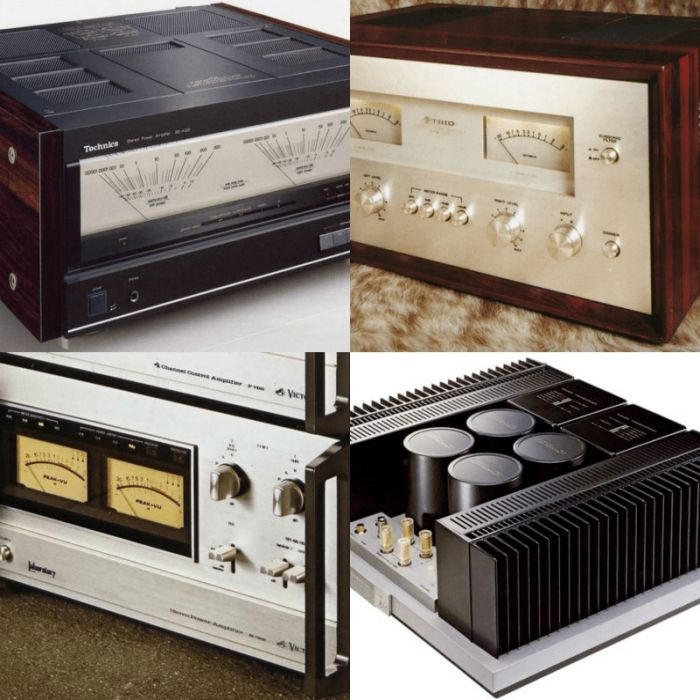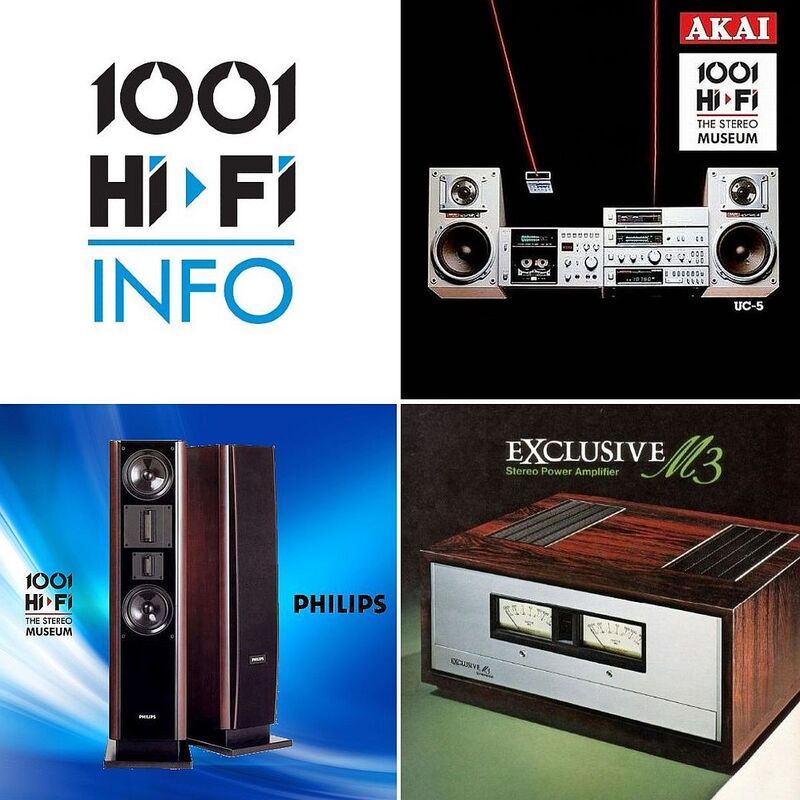AMPLIFIERS 1991 - 2000
The 1001 Hi-Fi Collection
Fine Arts by GRUNDIG V12 (1995)
Introduced in 1995 this amplifier is a member of the second generation of Fine Arts components by GRUNDIG. There is a strong focus on the visual appearance of these components which all share the same design pattern for all components. Build quality is still high quality with a rigid chassis construction, aluminum front and discrete amplifier construction. Secondary functions are nicely concealed behind a flip down panel that runs across the bottom half of the fascia. Another interesting feature is the (switchable - DOT) direct operation system. With this feature activated the components of the system communicate with each other. If you are listening to a radio station with a simple press of play on the CD player the disc will start to play and the amplifier switches from tuner to CD and all this is remote controllable with the system remote control. In order to use this system, you have to connect a cable between the RC-BUS connectors of the components. During this period GRUNDIG had strong ties with PHILIPS witch means that you can use the system with a PHILIPS remote control and the RC-BUS system control is the same with the PHILIPS (marantz) RC-5 remote system. This system of components communicating with each other was introduced by PHILIPS with their 900 series components. (Several 900 series components can be found in our collection too). You can read more about the matching cassette deck on this page. Technical data: 70 W/ch Sinus DIN 4-ohm, Distortion: 0.008% Dimensions: 435 x 125 x 300 mm
Cover Photo Art: The Opera - Published March 15th 2017
Cover Photo Art: The Opera - Published March 15th 2017
GRUNDIG M30-R (1995)
The M30-R is the heart of a "designer series" 26cm wide mini Hi-Fi system introduced by Grundig in 1995. The great thing about this unit is the fact that it can be used as a standalone amplifier in any system, any configuration. The M30-R is actually a receiver (tuner-amplifier) and it is based on the M30-A amplifier of the same series (also part of the 1001 Hi-Fi collection). The radio section of the M30-R features LW, AM and FM-Stereo with 59 preset stations. The FM section also features RDS (Radio-Data-System) for station name display and various other information sent by the radio station. The amplifier section is an impressive sounding 50W/ch model with bass, treble, balance and loudness control. The M30-R has a dedicated remote control unit for input selection, system component controls and volume adjustment via the motorized volume control. Actually the M30-R can be remote controlled with any other remote controller from this series. One can even use a Philips remote controller as it is based on the Philips remote control protocol. At the back of the unit we can find inputs for Phono, CD, DCC (in/out), Aux, Tape (in/out), system remote socket, antenna socket and the loudspeaker connectors for one pair of loudspeaker that can range between 4-16oHm. Matching components are the M30-CD CD player and the M30-CCF double cassette deck. Made by Grundig in Portugal.
Cover Photo Art: Performing Arts - Published May 15th 2024
Cover Photo Art: Performing Arts - Published May 15th 2024
KENWOOD KR-A5060 (1994)
This is a nice "little" (100 W/ch) stereo receiver from the 1994 Kenwood Hi-Fi Stereo line-up. The amplifier section features the Kenwood VIG (Voltage Interface Gate) circuit. This is an advanced technique of phase circuits for power amplification, which guarantees an adequate dose of "clean" power to support a natural and undistorted reproduction of dynamic signal peaks. Rated power output in Stereo operation is 100 W/ch min. RMS, 8 Ohm 20 Hz to 20 kHz with no more than 0.09% total harmonic distortion. The amplifier features the usual tone controls for Bass at 100 Hz (+/-10 dB), Treble at 10 kHz (+/-10 dB) and Loudness control. The amplifier can be used with two sets of loudspeakers (for multiroom operation) and it has provision for 6 analog inputs (two of them being for rec. and play). For source selection there is a rotary encoder for step-by-step source selection. The radio section has a 20 FM/AM station memory bank while the FM section also features RDS (Radio Data System). For radio station tuning you have manual, automatic or direct frequency input options. The amplifier can be remote controlled and it features cable remote connectors for various sources connected to the KR-A5060. Size of the unit is 440*133*379 mm with a Netto weight of 8.8 kg. The Kenwood KR-A5060 from our collection had missing volume and tone control knobs. The tone control knobs you see in the pictures are homemade knobs while the volume knob is a black painted, spray can cap ... adapted to fit. (Original sale price in Germany DM 599. Made in Korea)
Cover Photo Art: Hit a Chord - Published September 15th 2020
Cover Photo Art: Hit a Chord - Published September 15th 2020
PHILIPS FR900 (1991)
The FR900 from Philips was more than just a stereo receiver (tuner-amplifier), it was the heart of the "Easy Line 900" Hi-Fi system from 1991. While this receiver can be operated as a standalone unit fitted with Phono and Aux. input, the Tape and CD section will only work with the matching cassette recorder and CD player (see the last photo of this complete set). These are operated via the dedicated cables and both units will display all the essential information on the large centralized display of this receiver. Also, the operation controls of the cassette deck and CD player are located on the "center console" of this FR900 receiver. Focusing more on the amplifier section of this model reveals a "technological tour-de-force". This amplifier is a Class G amplifier - The Ultimate Amplifier Technology... Conventional Class A and Class AB design have good points and bad points while Class G is complex to design, but engineered correctly, is a clever solution. This offers greater efficiency and transparency, with less wasted heat energy. Like a hybrid car engine, Class G implements multiple power supplies rather than just a single supply. If a dynamic signal is received that goes beyond the capability of this first power supply, the secondary supply is gradually brought in up to full rated power output as required. This gives a very efficient design as additional power is only used when required, much like a turbo-charger. As the secondary supply is only used when required, extreme levels of power are possible because very little energy is wasted in the amplifier as heat when it is not being used. Without control this power would be ill-used, so like high performance car tyres, multiple output devices within the amplifier keep a tight grip on the loudspeaker at all times, ensuring your listening experience never “leaves the road”. Technical data: Power output - 70W/ch (8ohm DIN) | Distortion: <0,09 %/57W | Dimensions: 36x33,3x36cm...and it is very heavy... | System remote control as standard.
Cover Photo Art: It's So Easy - Published March 15th 2024
Cover Photo Art: It's So Easy - Published March 15th 2024
PHILIPS FA-931 (1994)
The FA-931 amplifier is part of the famous state-of-the-art 900 Series from PHILIPS. The 900 Series components were first introduced in 1992 to complement the newly invented, by Philips, Digital recorder, the DCC. The FA-931 presented here is the second-generation model and it was introduced in 1994. The amplifier features a series of advanced technologies for both powerful sound and comfort functions. The I-XDA (Intelligent Extended Dynamics Amplifier) circuit will regulate the power level of the amplifier in such a way that the optimal level of dynamic sound is reached without jeopardizing the safe operation of the amplifier-loudspeaker combination. This fuzzy logic power controller checks the output power level continuously. When very high power is demanded by the speakers over a prolonged period of time, the Fuzzy Logic Power Controller is ready to come in action to regulate the power level of the amplifier in such way that both parts of the XDA amplifier can be used to their maximum extend, and the speakers are driven to their highest sustainable power level. The FA-931 has a wide range of inputs and outputs for maximum flexibility. There is provision for Phono, Tuner and 3 Tape Play/Rec sockets (DCC, Tape, VCR), 2-pair of loudspeaker connectors for multiroom use, 3-power sockets, external EQ (Processor) connectors, 2-types of system remote control and Coaxial Digital In/Out. It has to be noted that there is no Digital to Analog converter in this amplifier, the digital input only facilitates digital copy from CD, DSR to DCC.
In terms of comfort, the ESI (Enhanced System Intelligence) is offering increased ease of operation by extensive communication between various components used with the amplifier. To benefit all the functions of the ESI system, all components must be connected via their ESI BUS socket to the dedicated ESI socket on the amplifier. The FA-931 was delivered with a full function system remote control that will operate all your audio and video components. In addition to this, the remote controller has a separate volume control for your TV that will control many older and newer Philips TV sets as well. Also, the REC button on the remote that was intended for a DCC recorder, will control later generation Philips CD Recorder as well. The amplifier can be fully switched off with the power button, or it could enter stand-by mode if the system is switched off with the remote control. When in stand-by mode you can "wake-up" the system either with the remote or simply touching the source selector (Magic Touch), but there is more. If there was a disc in the CD player when you've turned off the system from the remote you can simply press "3" on the remote or the CD player keypad and the system will turn on, CD will be selected and playback of track "3" will start. Also, if the "Auto Select" function is turned on a series of automatic source selection or automatic stop can be performed. For example: If you press PLAY for the CD while listening to the tuner, the source will automatically switch to CD and playback of the disc will start. If you press a tuner preset while listening to CD, the CD will be stopped and the selected radio preset will play. Using a Philips EM 2200/2201 "Pyramid" wired remote control receiver connected to the RC-5 socket will allow you to place this remote receiver in a different room (where the second pair of speakers are installed) allowing the system to be remote controlled from that room. Technical specifications: 2x80W, DIN 1kHz, 6ohm, Music power: 2x185W, 1kHz, 8ohm | Total harmonic distortion <0.009% at 85W for 1kHz | Dimensions: 435x140x300 mm | Weight: 7.2 kg. The front panel is plastic but the whole amplifier has a solid housing while the volume and source selectors are actually metallic (needed for the Magic Touch operation).
Cover Photo Art: Is It Live? - Published February 15th 2022
In terms of comfort, the ESI (Enhanced System Intelligence) is offering increased ease of operation by extensive communication between various components used with the amplifier. To benefit all the functions of the ESI system, all components must be connected via their ESI BUS socket to the dedicated ESI socket on the amplifier. The FA-931 was delivered with a full function system remote control that will operate all your audio and video components. In addition to this, the remote controller has a separate volume control for your TV that will control many older and newer Philips TV sets as well. Also, the REC button on the remote that was intended for a DCC recorder, will control later generation Philips CD Recorder as well. The amplifier can be fully switched off with the power button, or it could enter stand-by mode if the system is switched off with the remote control. When in stand-by mode you can "wake-up" the system either with the remote or simply touching the source selector (Magic Touch), but there is more. If there was a disc in the CD player when you've turned off the system from the remote you can simply press "3" on the remote or the CD player keypad and the system will turn on, CD will be selected and playback of track "3" will start. Also, if the "Auto Select" function is turned on a series of automatic source selection or automatic stop can be performed. For example: If you press PLAY for the CD while listening to the tuner, the source will automatically switch to CD and playback of the disc will start. If you press a tuner preset while listening to CD, the CD will be stopped and the selected radio preset will play. Using a Philips EM 2200/2201 "Pyramid" wired remote control receiver connected to the RC-5 socket will allow you to place this remote receiver in a different room (where the second pair of speakers are installed) allowing the system to be remote controlled from that room. Technical specifications: 2x80W, DIN 1kHz, 6ohm, Music power: 2x185W, 1kHz, 8ohm | Total harmonic distortion <0.009% at 85W for 1kHz | Dimensions: 435x140x300 mm | Weight: 7.2 kg. The front panel is plastic but the whole amplifier has a solid housing while the volume and source selectors are actually metallic (needed for the Magic Touch operation).
Cover Photo Art: Is It Live? - Published February 15th 2022
TELEFUNKEN HA 680 (1991)
This slim and compact (440x72x290 mm) amplifier was part of the 1991 Telefunken Hi-Fi component lineup. With a power rating of 40 W/ch into 8Ω it was the smallest of the range. Even though it seems like a modest amplifier this is actually a very good sounding model. It also features a total of 6 inputs where one is for Phono and two are for cassette recorders with recording output facility. Unusual, it also features two inputs for in-out of video signal too. The input selector is electronically controlled with a row of large LEDs for status display. Another unusual feature is the possibility of connecting 4 loudspeakers to the amplifier for an enhanced (surround) sound field. The electronic components are mounted in a plastic chassis (bottom and side panels are one piece). The front panel is also plastic but the large volume knob is metallic. The whole structure is covered with a conventional steel cover that also includes the back panel too. Overall, this construction feels very robust and solid.
Cover Photo Art: Eine Welt voll Musik - Published July 15th 2020
Cover Photo Art: Eine Welt voll Musik - Published July 15th 2020
YAMAHA RX-350 (1991)
This is a very nice, compact and good sounding receiver from the 1991 YAMAHA lineup. The amplifier section features the usual bass, treble and balance control complemented by a Bass Extension circuit, variable Loudness and CD Direct circuit. There is provision for Phono, CD, AUX input and Tape monitor function. Two pairs of loudspeakers can be connected for multiroom operation if desired.
Your favorite radio stations can be stored into the 16 random access preset programs. The tuner (radio) section uses a Direct PLL Synthesizer Tuning System with automatic or manual electronic tuning. Signal strength is displayed by a 5-segment tuning level indicator on a clear a legible display where also the selected memory (program) is displayed. This model was available in both Titanium and Black finish. Technical data: 35 W/ch (8 ohm), THD: 0.01%, Signal to noise: PHONO 82 dB CD/TAPE 103 dB,
Dimensions 435 W x 131 H x 292 D mm, Weight 5.2 Kg
Cover Photo Art: April Jazz - Published April 15th 2018
Your favorite radio stations can be stored into the 16 random access preset programs. The tuner (radio) section uses a Direct PLL Synthesizer Tuning System with automatic or manual electronic tuning. Signal strength is displayed by a 5-segment tuning level indicator on a clear a legible display where also the selected memory (program) is displayed. This model was available in both Titanium and Black finish. Technical data: 35 W/ch (8 ohm), THD: 0.01%, Signal to noise: PHONO 82 dB CD/TAPE 103 dB,
Dimensions 435 W x 131 H x 292 D mm, Weight 5.2 Kg
Cover Photo Art: April Jazz - Published April 15th 2018

